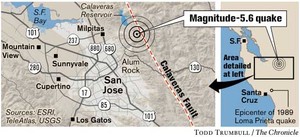
|
Nearly 40 small aftershocks struck on the Calaveras Fault on Wednesday, following Tuesday night's moderate earthquake near San Jose that startled residents throughout the Bay Area.
The 5.6-magnitude quake caused only minor damage in South Bay communities, and the aftershocks - the largest at 3:54 p.m. with a magnitude of 3.7 - occurred south of the main quake's epicenter near the Calaveras Reservoir, according to Tom Brocher, a seismologist with the U.S. Geological Survey in Menlo Park.
Brocher said the succession of aftershocks indicated that the fault was rupturing southward - a good sign - because most of the main quake's energy was being dissipated well away from the more dangerous Hayward Fault to the north. But there is always the possibility that the quake's abrupt release of stress inside the Calaveras Fault might have changed stresses that have long built up within the Hayward Fault, Brocher said. The temblor on the Calaveras, therefore, could have slightly increased the likelihood of a larger quake on the Hayward, by about 5 percent, he said.
The most recent official report by earthquake experts has placed the probability that a destructive quake will strike within the next 25 years on the Hayward Fault with a magnitude of 6.7 or greater at 27 percent. It also estimated the probability of a similar quake on the Calaveras at 11 percent in the same period.
On Wednesday, the State Office of Emergency Services convened a conference call among members of the California Earthquake Prediction Evaluation Council, the scientists who advise the state on seismic issues. The council members agreed that Tuesday's temblor "significantly increased" the probability of a damaging quake on the Hayward or the Calaveras faults over the next few days, but added that "the overall likelihood of such an event is still low."
Tuesday night's temblor, which struck shortly after 8:04 p.m., has been named the Alum Rock quake, after a small neighborhood on the eastern edge of San Jose near the epicenter.
On Wednesday, teams of federal and state geologists surveyed the ground along the fault, seeking cracks in the earth that might have been caused by the quake, which struck 5.7 miles beneath the surface. They found nothing, Brocher said.
But for such a moderate quake, the public response throughout the Bay Area was remarkable, he said, and 61,000 people used their computers to report to the USGS that they felt the shaking clearly - with descriptions of the motion varying from weak to strong. Many residents said they felt the temblor lasting as long as 30 seconds.
"That kind of information is very valuable," Brocher said, "and we can use it to learn more about the behavior of quakes."
The Calaveras Fault has produced at least six small earthquakes in the past 15 years, including one with a magnitude of 4.9; in 1984 a much larger one struck near Morgan Hill with a magnitude of 6.2 and damages in the Santa Clara Valley totaling more than $10 million.
To Brocher, the major lesson from Tuesday night's temblor is that much larger quakes are always a threat and that every Bay Area resident should maintain a well-stocked earthquake survival kit with emergency supplies and keep its contents updated so they don't turn out to be useless if a Big One hits.
Damage from the quake was minor but widespread near the quake's epicenter.
There were small landslides, a downed tree and damage to a trestle bridge in Alum Rock Park, and one landslide partially blocked a road in the park, which is perched in the hills east of downtown San Jose.
In downtown San Jose's Dr. Martin Luther King Jr. Library, books that fell from the shelves were scattered all over the floor, but the library was open with limited access on Wednesday as the books were reshelved, and a single file cabinet fell over in City Hall, said Mona Favorite-Hill, a spokeswoman for the city manager's office.
The dam at the Calaveras Reservoir, which is the largest local reservoir in the San Francisco Public Utilities Commission's water storage network, was being inspected Wednesday, but was believed to have suffered no damage, PUC spokesman Tony Winnicker said.
"The dam is stable, and there's been no change in any of the water pressure readings," Winnicker said. There have been no pipeline breaks or tunnel problems detected elsewhere in the PUC's network, he said.
The San Jose Fire Department responded to four calls of flooding from broken pipes, four more about leaking natural gas pipes, and 40 from people asking for medical assistance during the roughly three hours after the quake hit, according to Fire Capt. Craig Schwinge. None of the emergency calls involved serious trauma or heart attacks, he said.
Chronicle staff writer John Coté contributed to this report.



Reader Comments
to our Newsletter